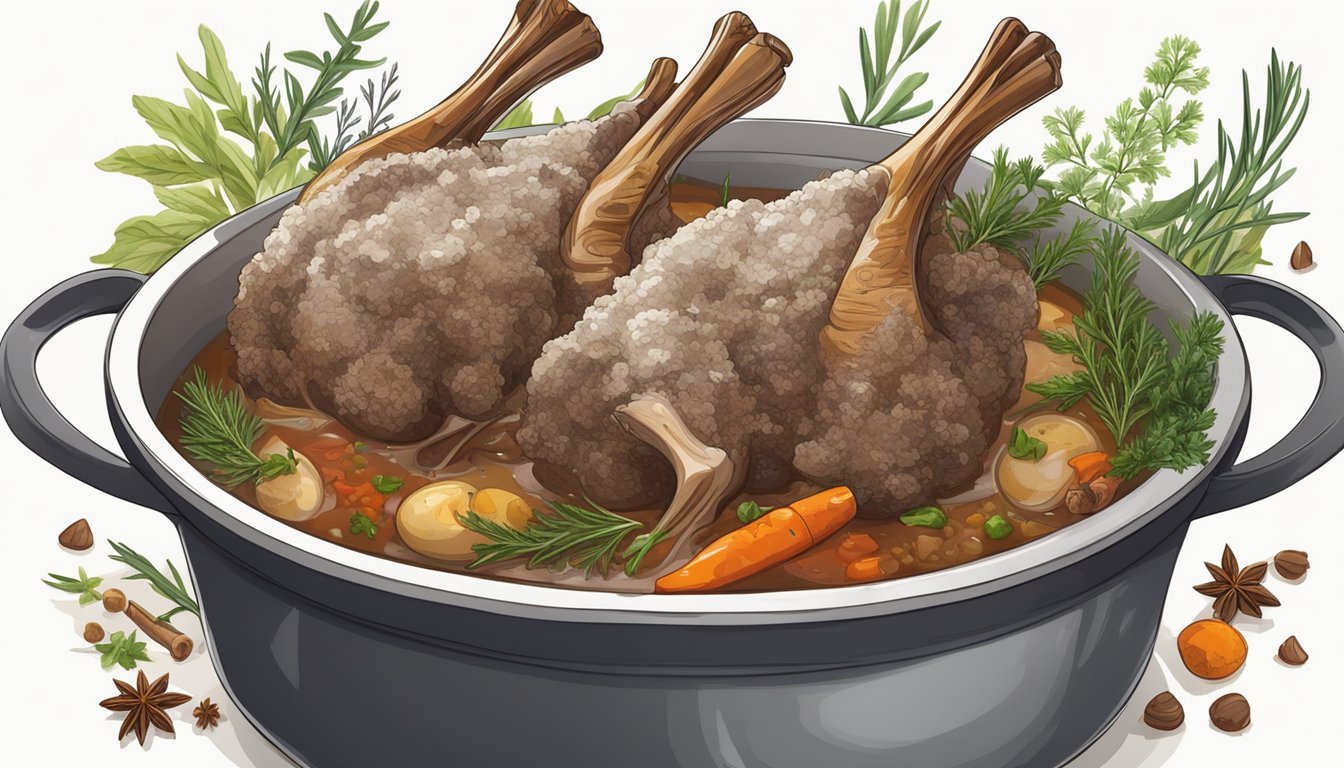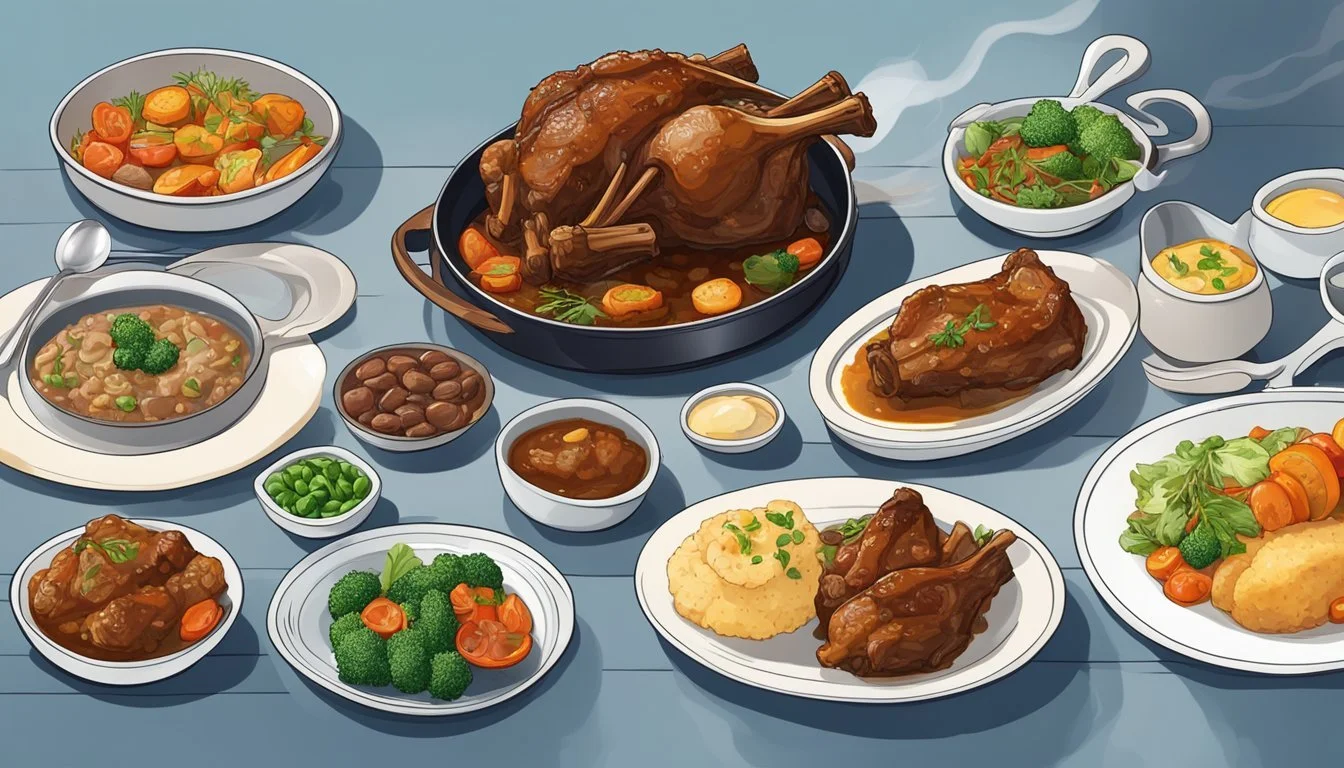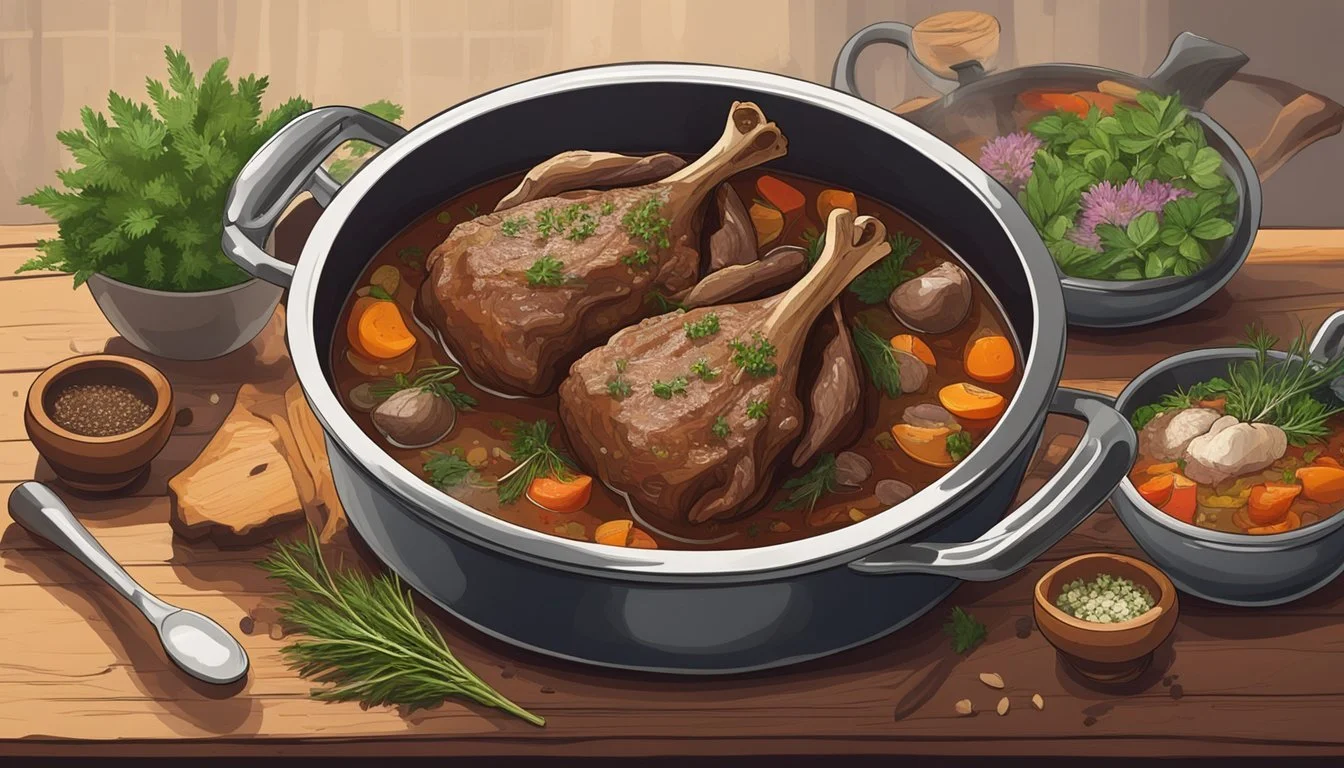Best Way to Reheat Braised Lamb Shanks
Ensuring Tender and Succulent Results
Braised lamb shanks are lauded for their succulent, tender meat that effortlessly falls away from the bone, a characteristic that food lovers and chefs alike strive to preserve when reheating leftovers. To maintain this quality, a reheat should not only warm the lamb shanks through but also ensure the meat remains as flavorful and tender as when it was first cooked. Achieving the perfect reheated braised lamb shank is a gentle process that asks for patience and careful attention to detail.
A correct reheating procedure can effectively replicate the slow-cooked environment in which the lamb shanks were originally braised. This involves using low heat and a moist environment to preserve the shank’s tenderness. Covering the lamb shanks with foil while adding a small amount of stock or water can recreate the braise's moist conditions. A low-heat oven, typically set around 325°F, is ideal for warming the meat evenly without drying it out or toughening the fibers, which ensures that the lamb retains its much-desired fall-off-the-bone texture.
When reheating, it’s essential to consider the distribution of heat within the meat. Lamb shanks are best reheated until the internal temperature reaches a safe and palatable level. Using a meat thermometer to check the shank's thickest part, away from bone or fat, gives an accurate reading ensuring the meat has been reheated thoroughly. This attention to detail safeguards the flavor and texture of the braised lamb shanks, providing a result that is practically indistinguishable from the freshly cooked dish.
Understanding the Basics of Braised Lamb Shanks
Braised lamb shanks combine low-temperature cooking with moist heat to produce remarkably tender meat with rich, deep flavors.
What Makes Lamb Shanks Ideal for Braising?
Lamb shanks are cuts from the lower leg of the lamb, replete with connective tissue that makes them tough if improperly cooked. They are revered for braising due to their marbling and collagen, which, when broken down over several hours of low, wet heat, transform into gelatin—imbuing the meat with succulence and rich texture.
Key Elements for Achieving Tender Lamb Shanks
For lamb shanks to reach the pinnacle of tenderness, several factors are paramount:
Consistent, Low Heat: Braising should occur at temperatures around 325°F (163°C), ensuring the connective tissues break down without the meat drying out.
Flavor Development: Searing the lamb shanks before braising heightens their flavor profile. This crucial step creates a crust that seals in juices and adds complexity to the dish.
Moisture: Braising liquid—whether it's broth, water, or wine—facilitates even heat distribution while helping to meld flavors and prevent the meat from drying during the lengthy cooking process.
Preparation Before Reheating
Proper storage and preparation of braised lamb shanks are critical steps to ensure that the meat remains tender and flavorful when reheated. One should focus on effective storage techniques and correct thawing methods if the lamb shanks have been frozen.
Storing Lamb Shanks Effectively
To maintain the quality of braised lamb shanks, they should be stored in the fridge as soon as they have cooled down. For optimal preservation:
Fridge: Place the lamb shanks in an airtight container or wrap them tightly with plastic wrap to prevent air exposure.
Duration: Refrigerated lamb shanks will keep for up to 3 days.
Airtight Container: Utilizing an airtight container also helps to retain moisture, which is crucial for keeping the lamb tender.
Thawing Frozen Lamb Shanks Correctly
If the lamb shanks have been stored in the freezer, proper thawing is necessary to prevent the growth of harmful bacteria and to ensure uniform reheating.
Freezer to Fridge: Transfer the frozen lamb shanks to the fridge and allow them to thaw slowly; this can take up to 24 hours depending on the size.
Uniform Thawing: Ensure that they completely thaw to achieve even reheating later; partial thawing can lead to uneven cooking.
Safety Tip: One should never thaw lamb shanks at room temperature to avoid the danger zone where harmful bacteria can proliferate.
Reheating Techniques for Optimal Tenderness
Reheating leftover braised lamb shanks requires careful attention to temperature and moisture to maintain their sumptuous, fall-off-the-bone quality. Selecting the right method and following specific steps can make a significant difference in preserving the meat's tenderness and flavor.
Oven Reheating Method
Reheating in the oven is an excellent method for keeping the lamb shanks tender. To do this effectively:
Preheat the oven to 325°F (163°C).
Place the lamb shanks in a baking dish and cover them with foil or a lid to retain moisture.
Reheat for about 20-30 minutes, checking for desired temperature.
Stovetop Reheating Method
Using a pot on the stovetop to gently reheat the lamb shanks can yield great results.
Add the leftover lamb shanks to the pot, incorporating a few tablespoons of broth or water to add moisture.
Cover the pot and reheat on low heat, simmering for 15-20 minutes.
Occasionally baste the meat with the cooking liquid for enhanced flavor.
Utilizing Slow Cooker or Instant Pot
A slow cooker or an Instant Pot can reheat lamb shanks thoroughly while keeping them moist.
Set the slow cooker or Instant Pot to the "Warm" setting.
Add a bit of stock or water to the bottom of the pot, and place the lamb shanks inside.
Allow them to reheat for 1 to 2 hours, ensuring the meat remains tender and does not dry out.
Microwaving: When and How to Do It Properly
When time is of the essence, microwaving can be a viable option if done correctly.
Shred the lamb meat off the bone and place it in a microwave-safe dish.
Add a splash of stock or water to retain moisture, and cover the dish with a vented lid or microwave-safe plastic wrap.
Microwave on 50% power in short bursts of 30 seconds, stirring in between to ensure even reheating.
Safeguarding the Flavor and Texture
When reheating braised lamb shanks, it's crucial to maintain the delicate balance of flavor and texture that braising achieves. Consistent heat, moisture, and careful addition of liquids and aromatics can ensure the lamb remains succulent and flavorful.
Managing Heat and Timing
To avoid overcooking, one should reheat lamb shanks in an oven set to a moderate temperature, around 325°F (163°C). The duration of reheating should be sufficient enough to warm the meat throughout but short enough to prevent drying. Roughly 20-30 minutes should suffice, depending on the size of the lamb shanks.
Key Points:
Preheat oven to 325°F (163°C)
Reheat lamb shanks for 20-30 minutes
Maintaining Moisture and Preventing Dryness
The retention of moisture is paramount for keeping reheated lamb shanks tender. One should wrap the shanks in foil, creating a tight seal to lock in humidity. The natural fat from the meat, such as the one found in braised lamb, plays a pivotal role, as it helps to keep the meat moist and enhances its succulent flavor profile.
Key Steps:
Cover shanks with aluminum foil
Utilize the fat from the shanks
Adding Liquids and Aromatics During Reheating
To elevate the aromatic quality and tenderness of reheated lamb shanks, one can supplement with liquids like beef or chicken stock, which should be heated beforehand to simmer. Aromatic vegetables such as onions, carrots, and garlic cloves, along with a dash of olive oil, enrich the overall flavors. For those who appreciate a touch of bacon flavor, incorporating finely chopped pieces could add additional depth.
Ingredients for Enhancing Aromatics:
Heat braising liquid such as beef stock or chicken stock before adding
Include aromatic vegetables: onions, carrots, garlic cloves
Consider a touch of bacon for depth
Lightly coat with olive oil
Complementary Dishes and Side Pairings
When serving braised lamb shanks, the selection of side dishes and wine can transform the meal. Thoughtful pairings bring out the rich flavors of the meat and enhance the overall dining experience.
Best Side Dishes for Braised Lamb Shanks
The tenderness of braised lamb shanks goes hand-in-hand with sides that can match its robust flavor profile. A classic choice is buttermilk mashed potatoes, which provide a creamy texture and slight tanginess that complements the lamb's richness. Adding minced garlic and chopped parsley to the potatoes can elevate the dish further. For those looking for a lighter accompaniment, a tomato risotto infused with rosemary offers a Mediterranean twist, balancing the heartiness of the lamb with its bright and aromatic flavors.
To cater to preferences for greens, one might consider green beans tossed with sautéed mushrooms. They provide a complementary earthy flavor that pairs well with the meat's savory depth. Alternatively, a simple yet flavorful side could be roasted carrots glazed with a touch of honey for a blend of sweetness and warmth.
Wine Pairings to Enhance the Meal
Selecting the right wine can elevate the lamb to new heights. For braised lamb shanks, full-bodied red wines are typically recommended. Merlot offers a balance with its soft tannins and notes of black cherry, playing well against the gamey taste of the lamb. Cabernet Sauvignon, known for its bold flavor with hints of dark fruits and spice, stands up to the strong flavors of the meat. For a more delicate meat preparation, a Pinot Noir can introduce a lighter touch with its subtle notes of berries and a gentle earthiness that won't overpower the lamb.
To present these pairings, a simple table can be helpful:
Dish Type Suggested Pairings Mashed Potatoes Garlic, Parsley Risotto Tomato, Rosemary Vegetables Green Beans, Mushrooms, Roasted Carrots Wine Merlot, Cabernet Sauvignon, Pinot Noir
By considering these pairings, one ensures a meal where every element works in harmony, resulting in a truly memorable culinary experience.
Pro Tips for Perfectly Reheated Lamb Shanks
Proper technique ensures that braised lamb shanks retain their tenderness and flavor when reheated. The key lies in gentle warming and using the right seasonings and garnishes.
Utilizing Fresh vs. Dried Herbs
When reheating lamb shanks, the choice between fresh and dried herbs can impact the flavor profile. Dried herbs are more concentrated and potent, ideal for the cooking process. However, once the shanks have been braised and are being reheated:
Fresh Herbs: Add fresh herbs like rosemary during the last few minutes of reheating to imbue the lamb with a bright, aromatic flavor.
Dried Herbs: If only dried herbs are available, one should use them sparingly, as they have already imparted their essence during the initial cooking.
For both, it's vital to consider the balance of flavors; a little goes a long way.
Garnishes to Add After Reheating
Garnishes not only add visual appeal but also enhance the taste of lamb shanks post-reheating. Consider the following additions:
Black Pepper & Kosher Salt: A simple seasoning with freshly ground black pepper and a sprinkle of kosher salt can elevate the dish.
Garlic Cloves: Introducing roasted garlic cloves after reheating can add a sweet and mellow garlic flavor.
Olive Oil Drizzle: Finish the dish with a light drizzle of high-quality olive oil for added richness.
Fresh Herbs: Chopped fresh herbs such as parsley or mint provide a burst of freshness and color to the dish.
Each garnish should be applied after reheating to preserve its texture and potency, ensuring that every bite is as delicious as intended.
Storing Leftovers After Reheating
After enjoying a delicious meal of braised lamb shanks, proper storage of any leftovers is crucial for maintaining quality and safety. This section guides you through the correct practices to store reheated lamb shanks and outlines how long they can be kept before consumption.
Best Practices for Storing Reheated Lamb Shanks
One should transfer the lamb shanks to an airtight container immediately after reheating. A container with a tight-fitting lid is ideal to prevent the meat from drying out and to keep any bacteria from contaminating the dish. If there is leftover sauce or broth, ensure it's poured over the lamb to keep it moist.
Do not leave the lamb shanks at room temperature for longer than two hours, as this can encourage bacterial growth. They should be refrigerated as quickly as possible to preserve freshness.
How Long Can You Keep the Reheated Dish?
When it comes to the fridge, reheated lamb shanks can be safely stored for 3 to 4 days. Be mindful to cool the shanks to room temperature before placing them in the fridge, which helps to maintain a stable temperature within the appliance.
If one prefers to store the reheated lamb shanks for an extended period, freezing is a suitable option. In a freezer, the dish can be kept for up to 2 to 3 months. To freeze, one should wrap the shanks tightly in freezer-safe wrap or place them in a heavy-duty freezer bag to protect from freezer burn. When ready to eat, thaw the lamb shanks in the fridge overnight before reheating again.
Frequently Asked Questions About Reheating Lamb Shanks
What is the best method for reheating lamb shanks to keep them tender?
The preferred method is using the oven. Reheaters should preheat their oven to 325°F (163°C) and place the lamb shanks in an oven-safe dish. Covering the shanks with foil ensures they remain moist. The aim is to heat the meat slowly to preserve its fork-tender quality.
How long does it take to reheat lamb shanks in an oven?
Typically, reheating lamb shanks will take about 20-30 minutes, depending on size and quantity. It's important to check internal temperature or texture to ensure they are heated through and retain the desired fork tenderness.
Can you reheat lamb shanks with the sauce?
Yes. When lamb shanks are served in a rich sauce, one can add a little water or stock to loosen the sauce, if necessary, then cover with foil before placing in the oven. This helps in maintaining the flavorful aspect of the dish.
Is it safe to reheat lamb shanks in a microwave?
While it's possible, microwaving can unevenly heat and potentially toughen the meat. If one must use a microwave, it’s advised to shred the meat off the bone and cover it, reheating in short intervals to prevent overcooking.
What prep time is required before reheating?
Very minimal. One only needs to preheat the oven and prepare the dish for reheating, which includes possibly adding thyme or other herbs to refresh the dish's flavor profile. This should take no more than a few minutes.
Remember that all reheating methods should aim for an internal temperature of 165°F (74°C) to ensure safety and quality.
Sharing Your Meal Masterpiece
After perfecting the art of reheating braised lamb shanks to achieve that fall-off-the-bone tenderness, one might desire to showcase their delectable holiday meal to a wider audience. This section provides guidance on how to share the visual appeal of your lamb dish effectively on various social media platforms.
Engaging Through Social Media
Sharing your culinary achievements on social media platforms such as Facebook, Instagram, and Pinterest can connect you with fellow food enthusiasts and provide inspiration for their holiday meal plans. When posting on Facebook, ensure to include a captivating story about your cooking experience or the occasion, which can engage your friends and followers emotionally and encourage them to interact with your post.
Instagram, known for its visual appeal, demands high-quality images of your savory lamb shanks. Use relevant hashtags such as #BraisedLambShanks, #HolidayMeals, or #CulinaryMasterpiece to reach a broader audience who share your interest in gourmet cooking.
Capturing Your Dish for Instagram and Pinterest
The visual presentation of your lamb chops is paramount when capturing them for Instagram and Pinterest. Consider the following tips to make your images stand out:
Lighting: Ensure your dish is well-lit, preferably with natural light, to accentuate the rich colors and textures of the meat.
Plating: Present your lamb shanks on a dish that contrasts with the meat, highlighting its succulence.
Angles: Capture from multiple angles to showcase the braised lamb shanks' tender texture and the perfect sear on the chops.
Annotations: When pinning your image on Pinterest, include a brief description of the reheating method to emphasize the care taken to maintain quality.




